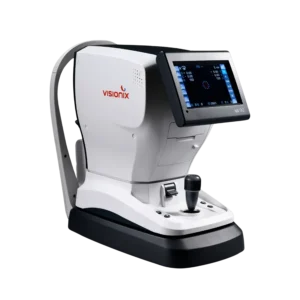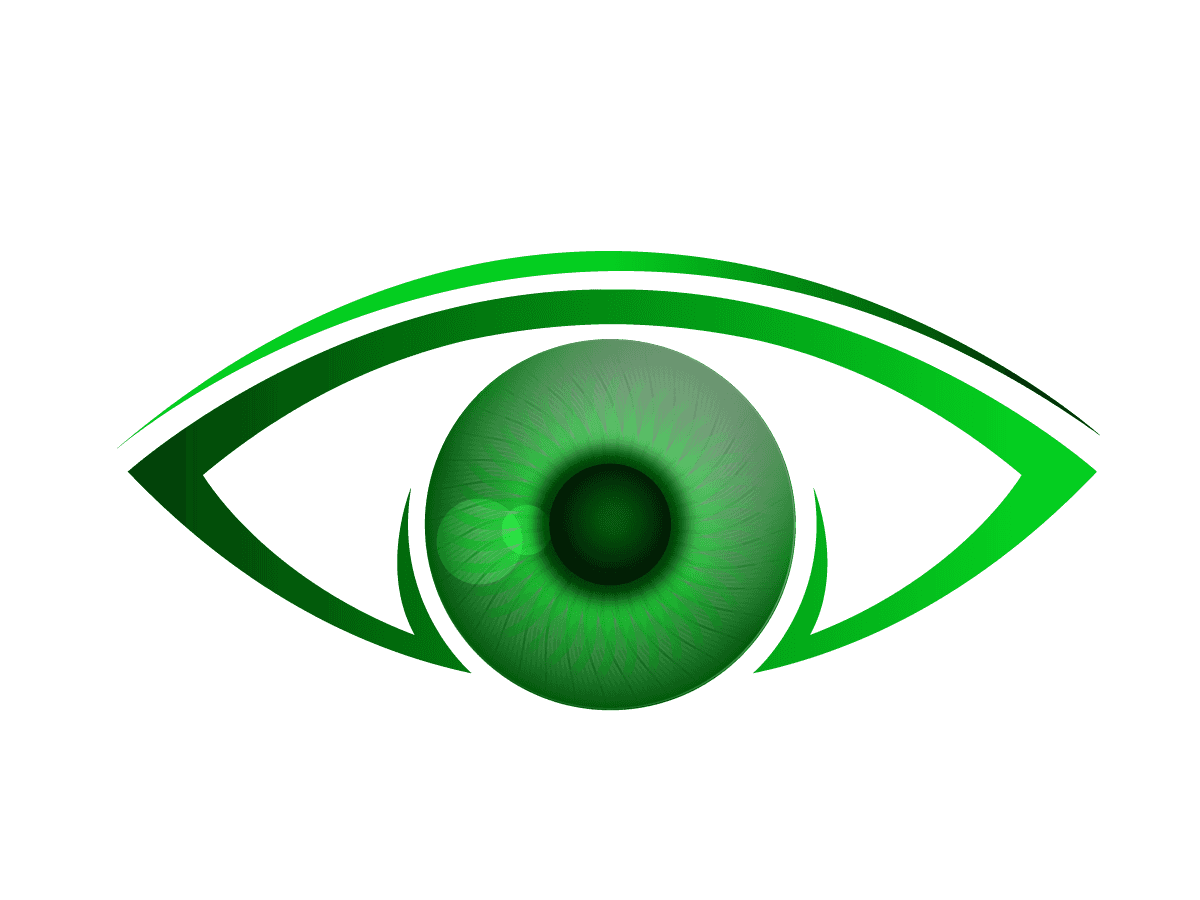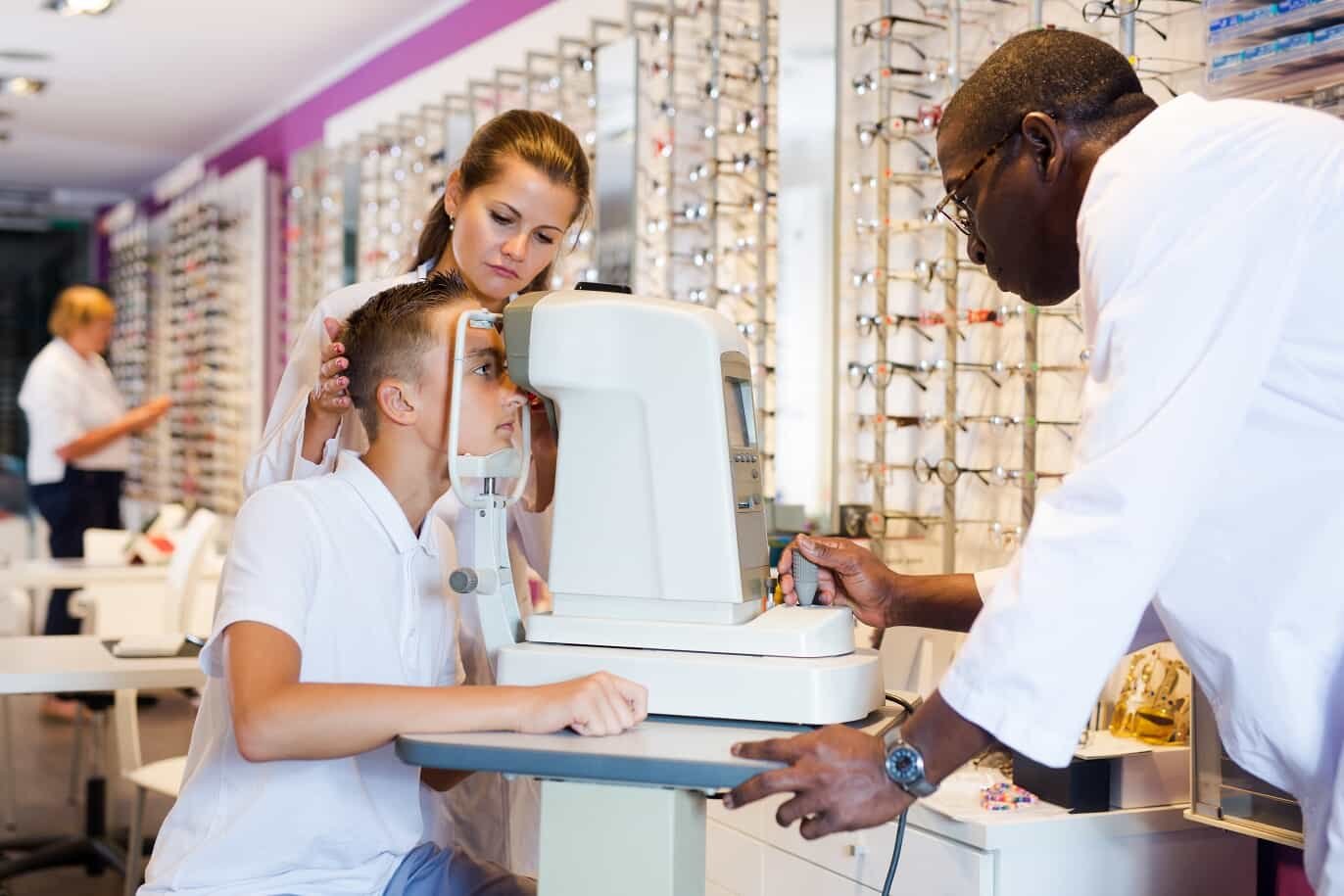Table of Contents
Autorefraction devices have become a go-to tool for Ophthalmologists. These advanced diagnostic devices can replace traditional retinoscopy techniques for determining refractive errors in patients. Paired with keratometric functionality, they detect astigmatism and aid in fitting the contact lens. Autorefractors are quick and accurate, which enhances the patient experience.
The market for autorefractor keratometers is always changing. Providers need to know how these tools can help their patients and improve their practice.
Introduction to Autorefractor Keratometers
An autorefractor keratometer is an ophthalmic diagnostic instrument that helps eye care professionals identify refractive errors, including astigmatism. The tabletop devices are easy for staff to use, offering patients a simple, stress-free experience. There is no need for dilation, immobilization, or numbing when using autorefraction. Clinicians can use it to screen patients of all ages, including children.
The autorefractor keratometer takes just seconds to calculate and print measurements. This makes it perfect for busy eye care practices with many providers. Using autorefraction and keratometry can improve workflows and reduce the time providers must spend determining patients’ prescription needs.
How Autorefractor Keratometers Work
Autofractor keratometers are tabletop devices that use infrared light to quickly and accurately measure the ocular fundus.
The staff directs patients to sit before the device and position their faces on a chin rest. The instructions tell them to look at an image projected on the device, often a hot air balloon or a starburst pattern.
The image moves in and out of focus while the patient trains their eyes. The device conducts a series of measurements, calculating the distance between the eye surface and the ocular fundus. The machine registers changes in measurements as the eye refocuses on the image.
In addition, the keratometry function measures the curvature of the anterior corneal surface. Some models can identify signs of cataracts as well.
The resulting measurements give providers a reliable assessment of both refractive error and the degree of astigmatism present. The autorefractor keratometers can print results or wire the information to the patient’s electronic health record.
Autorefraction and keratometry give an essential measure. Providers can use this as a starting point for subjective refraction with a phoropter. This subjective refraction process helps patients get the right corrective lenses for their vision needs. It considers their perception and the measurements from an autorefractor.
Autorefraction is a good option for providers who work with children or patients who cannot communicate well. You can use it alone to prescribe glasses because it is accurate enough.
Top 5 Autorefractor Keratometers for Ophthalmologists
1. ZEISS VISUREF 150 Autorefractor and Keratometer ($2,999.00)
Zeiss Visuref 100 is a reliable, affordable Autorefractor and Keratometer that providers can easily integrate into their practice. Zeiss Visuref 100 is suitable for all patients, including those with IOLs.

The Zeiss Visuref 100 has a color touch-screen monitor and joystick control for easy operation. A quick-release braking system prevents unintended movements during operation.
The device includes a motorized chin rest that you can easily adjust to maximize patient comfort. The chin and forehead rest are ergonomically shaped and easy to clean between patients.
The product description states:
The user-friendly interface measures cornea and pupil diameter. It also captures images and measures contact lens base curves. This is in addition to refraction and keratometry.
Adaptable illumination parameters allow measurements of patients with implanted intraocular lenses (IOLs). The automatic fogging incorporates an infinity scene that reduces the effects of accommodation.”
It had four operating modes:
- Combined refraction and keratometry
- Pupil and cornea diameter measurement
- Image capture
- Contact lens base curve measurement
Measurement Specifications:
- Sphere: -25.00 D to +22.00 D in increments of 0.12 D / 0.25 D
- Cylinder: 0.00 D to ±10.00 D in increments of 0.12 D / 0.25 D
- Axis: 0° to 180°, in increments of 1°
- Corneal vertex distance: 0.00, 10.00, 12.00, 13.50, 15.00 mm
- Pupillary Distance (PD): 10 mm to 85 mm
- Minimum pupil diameter: 2 mm
It has a built-in printer and wireless connectivity.
Size
- Weight (unpacked): 18 kg
- Height 275 mm
- Width 525 mm
- Depth 450 mm
2. Reichert OptoChek Plus ($3,699.00)
The OptoChek Plus Auto Refractor + Keratometer can be used alone or as part of the VisionChek™ Digital Exam Suite. Suitable for patients with IOLs and those with cataracts.
The OptoChek™ Plus Auto Refractor + Keratometer includes a 5.7” full-color LCD monitor display and advanced joystick control.

The device has an adjustable chinrest for patient comfort and optimal positioning. The OptoChek™ Plus Auto Refractor + Keratometer offers quick measurements to minimize the time patients need to remain in position. This improves the patient experience and increases patient throughput. The chin and forehead rest design provides comfort, and you can clean them quickly.
The product description states:
The new OptoChek® Plus Auto Refractor + Keratometer is part of the VisionChek™ Digital Exam Suite. It combines advanced technology with simplicity for your exam.
The OptoChek Plus has a new, compact design and a user-friendly interface. It provides the easiest way to measure spherical and cylindrical refractive errors, along with keratometry. Innovative Reliability Index gives you confidence in obtained readings.”
Measurement specifications:
- Sphere: -30D to +22D
- Cylinder: 0 to ± 10D
- Axis: 1 to 180°
- Corneal vertex distance: 0, 10, 12, 13.5, 15 mm
- Pupillary Distance (PD): 85 mm
- Minimum pupil diameter: 2 mm
It has a built-in printer and wireless connectivity. This allows it to send data to EMRs or any Reichert Digital Phoroptor.
Size
- Weight, unpacked: 28.1 Kg (12.8 lbs)
- Height: 46.4 cm (18.3 in.)
- Width: 22.9 cm (9.0 in.)
- Depth: 42.9 cm (16.9 in.)
3. Visionix VX-90 Autorefractor/Keratometer ($2,995.00)
This tabletop device features a moving fixation target with auto fogging for minimal accommodation and accurate measurements. The device can detect cataracts with backlighting to identify internal opacity.
The Visionix VX-90 Autorefractor/Keratometer has a tiltable LCD control panel. It also has a one-touch lock to stop unwanted movements while in use. The design includes a motorized chinrest that allows for precise adjustments and optimizes patient comfort. The device has an ergonomic design and is easy to clean between patients.

The product description states:
“The VX 90 provides autorefraction and keratometry data that is accurate, reliable, and essential for contact lens fitting. A moving fixation target with auto fogging allows for minimal accommodation.”
Measurement specifications:
- Sphere: -20 D to +20 D
- Cylinder: 0 to 10D
- Axis: 0° to 180°
- Corneal vertex: 5 mm to 10 mm
- Pupillary Distance (PD): 85 mm
- Minimum pupil diameter: 2.5 mm
It includes a built-in printer.
Size
- Weight, unpacked: 14 Kg (30 Lbs.)
- Width: 480 Mm (18.9 In)
- Depth: 288 Mm (11.3 In)
- Height: 500 Mm (19.7 In)
4. Huvitz HRK-9000A Autorefractor Keratometer ($2,666.00)
The Huvitz HRK-9000A offers wavefront technology for exceptional accuracy. The device includes meibomian gland analyzing function and tear film break up time measurements.
The Huvitz HRK-9000A includes a 7″ color LED display that users can position with both tilt and swivel. The designers created the chin and forehead rests for optimal stability and patient comfort. Manufacturers make the device from durable, easy-to-clean materials.

The product description states:
The unit has the first Contact Lens Fitting Assistance Guide in the world. This helps eye care professionals see fluorescein liquid with blue light.
The HRK-9000A has a full-color CCD camera and a white LED light. This helps the practitioner see the eyes and check the contact lens fitting. This was only possible before with slit lamps.
Measurement specifications:
- Sphere: -30.00 ~ +25.00
- Cylinder: 0.00 ~ 12.00D (Increments: 0.01, 0.12 and 0.25D)
- Axis:1~180°
- Corneal vertex: 0.0, 12.0, 13.5,13.75, 15.0
- Pupil distance (PD): 10 ~ 85mm
- Minimum pupil diameter: 2.0mm
It includes a built-in printer and wireless connectivity.
Size
- Weight unpacked: 41.8lbs
- Height: 17.4in
- Width: 10.3in
- Depth: 20.4in
5. Essilor AKR800 Auto Kerato-Refractometer ($6,900.00)
This autorefractor features complementary measurements, white-to-white measurements, retro-illumination imaging, night vision measurement, and accommodation evaluation.
The Essilor AKR800 Auto Kerato-Refractometer measures in just 20 seconds. This helps reduce the time patients spend in position. This enhances workflow efficiency and prioritizes patient comfort.

The product description states:
“With its smart design and quick, easy-to-use, fully automatic measurement system, you will improve your practice. It makes objective refraction easier.” It includes additional features such as keratometry and white-to-white contact lens fitting measurements. AKR800 enhances patient awareness and education with night vision refraction.”
Measurement specifications:
- Sphere: -30.00 +22.00
- Cylinder: 0.00 – 10.00D
- Axis:1~180°
- Corneal vertex: 0.0, 10.0 12.0, 13.5, 15.0
- Pupil distance (PD): 0-85mm
- Minimum pupil diameter: 2.0mm
It includes a built-in printer and LAN connectivity.
Size
- Weight unpacked: 48.5lbs
- Height: 19.0-20.6in
- Width: 10.6in
- Depth: 18.3in
Choosing the Right Autorefractor Keratometer
Autorefractor keratometers are a valuable addition to any proactive eye care. These devices offer a method for capturing precise, non-invasive measurements of refractive errors and corneal curvature. They help providers determine the best prescription for glasses and aid in fitting contact lenses.
Because autorefraction is so quick and comfortable, it enhances the patient experience. We can reduce patient wait times. Subjective refraction is faster and more efficient when providers have a good starting point. This helps them try out different corrections.
When choosing the right equipment for your practice, you should consider essential factors like price and how much space you need. In addition, you should consider factors such as:
- Measurement accuracy: Your patients rely on you to provide accurate prescriptions for vision correction. Autorefraction and keratometry should help make sure that glasses and contacts are correct. This can reduce the need for many appointments to fix prescription mistakes.
- Patient comfort features: Eye exams can be stressful, particularly for young patients. Equipment should not be intimidating or cause physical discomfort.
Choose an autorefractor with comfortable forehead and chin rests. It should adjust to different heights easily. Make sure it doesn’t need complicated instructions that could confuse patients.
- Compatibility with your electronic health records (EHR) is essential. Wireless syncing with EHR can reduce the need for data entry.
This saves valuable time for your staff. It can also ensure accuracy in recording patient data. Built-in printers give a good record for physical charts. However, syncing with electronic records makes office tasks more manageable.
- Specialized functionality: Your autorefractor and keratometer should meet the needs of your patients. A device that can work in patients with IOLs is critical if you see individuals with prior cataract surgeries. A handheld device might benefit pediatric patients who need to sit in a parent’s lap.
Contact our team to learn which autorefractor keratometer is best for your eye care practice. We are happy to answer any questions you have.
Frequently Asked Questions (FAQs)
What is the difference between an autorefractor keratometer and a standard autorefractor?
All autorefractors provide ocular measurements that determine refractive errors. Autorefractor keratometers can also measure anterior corneal curves to determine the presence and degree of astigmatism.
How accurate are autorefractor keratometer measurements?
Experts generally consider autorefractor keratometer measurements to be accurate. In studies, investigators found that repeated measurements yielded the same results. That suggests that the devices give accurate measurements, with minimal risk of operator error affecting the results.
Can autorefractor keratometers detect eye diseases?
Refraction does not detect eye disease, though some devices can indicate the presence of cataracts. To check for eye problems, patients should get a complete eye exam. This can help find issues like glaucoma, macular degeneration, or diabetic eye disease. This exam includes pupil dilation and screenings such as optical coherence tomography and intraocular pressure measurements.
Are autorefractor keratometers suitable for pediatric patients?
Yes, you can use autorefractor keratometers for children. It can be a helpful tool for prescribing glasses for children too young for a subjective refraction.
What is the average cost of an autorefractor keratometer?
The price of an autorefractor keratometer can vary. A basic model costs about $2,000. The most advanced devices can cost up to $30,000.

Matthew Strachovsky, M.D.
Dr. Strachovsky's undergraduate training began in Boston, Massachusetts at Boston University and was completed at Stony Brook University in Long Island, NY. There he graduated Summa Cum Laude, obtaining a Bachelor of Science degree in Biology with special recognition for academic achievement.
He continued his education at Stony Brook School of Medicine and graduated with the additional designation of the "MD with Recognition" program. He worked as an intern in Internal Medicine at Winthrop University Hospital in NY and pursued a residency at Stony Brook University Hospital in Ophthalmology acting as Chief Resident in his final year. He completed his fellowship training in Vitreoretinal disease with a major emphasis on the diagnosis and management of retinal vascular diseases under the direction of Dr. Michael O'Brien at Koch Eye Associates in Rhode Island.
Dr. Strachovsky has presented research at the annual Association for Vision and Research in Ophthalmology meeting and published articles in journals including, Investigative Ophthalmology and Visual Science and The Journal of Neuro-ophthalmology.
Dr. Strachovsky's professional interests include the management of Age-Related Macular Degeneration and diabetic eye disease. He is Board Certified in Ophthalmology and a member of the American Academy of Ophthalmology, American Society of Retina Specialists, Young Ophthalmologist Network, and Leading Physicians of the World.
" I believe that the physician/patient relationship is more important than ever. Being an Ophthalmologist allows me to help patients and build a foundation of trust, knowledge, and professionalism when it comes to eye care".


